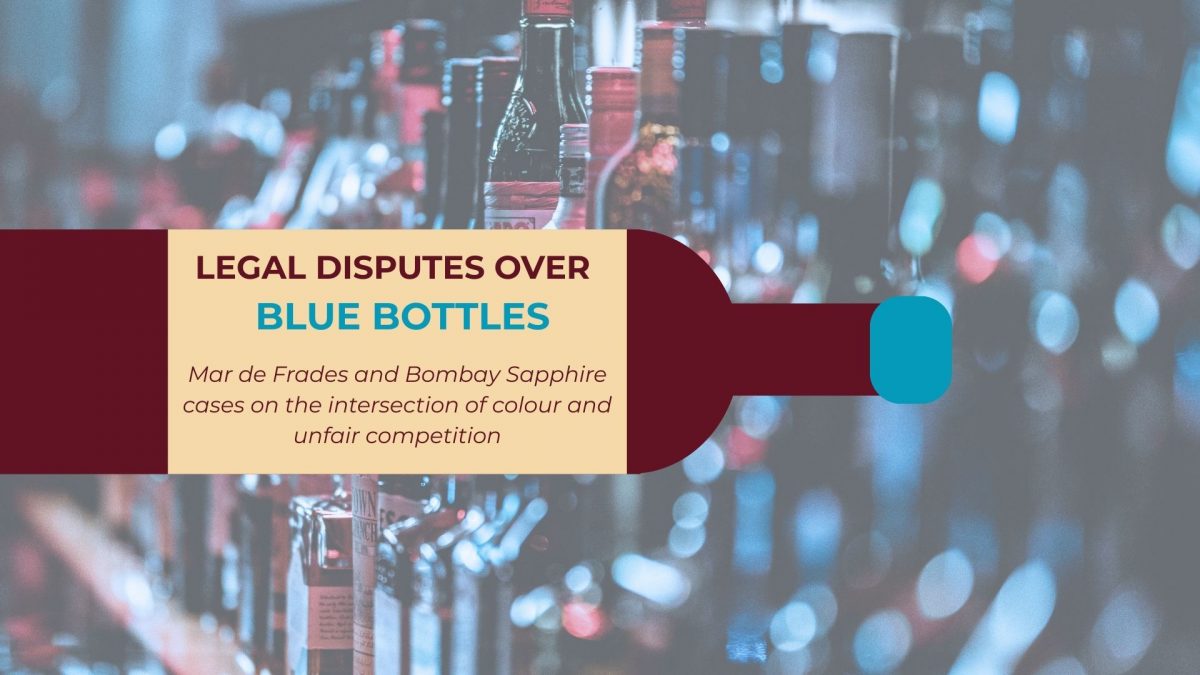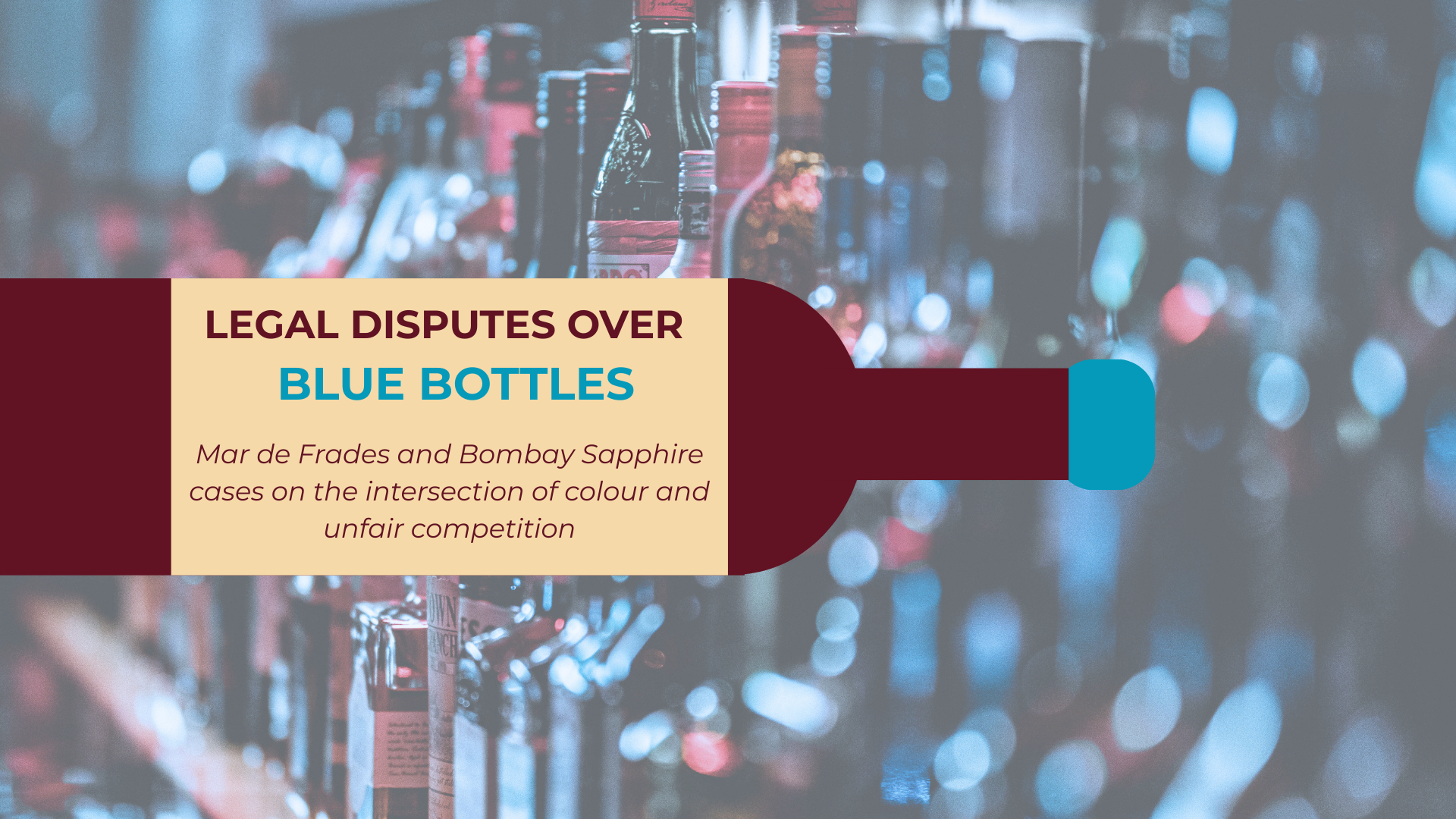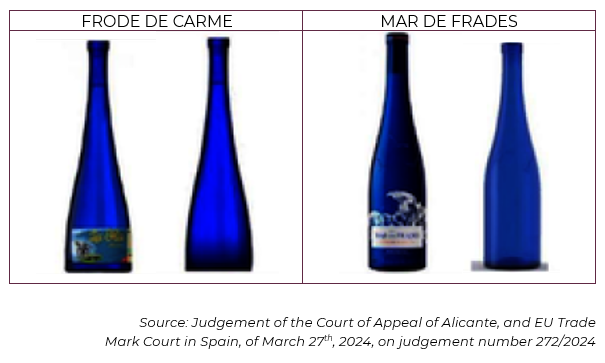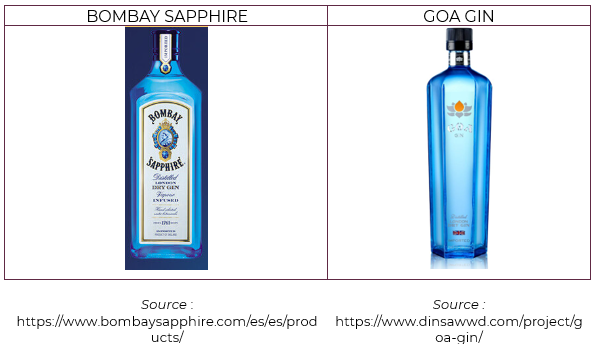

LEGAL DISPUTES OVER BLUE BOTTLES
A comparative of MAR DE FRADES and BOMBAY SAPPHIRE cases, on the intersection of colour and unfair competition.
Singular designs of the goods have become a practice for attracting consumers attention, whether due to the shape of the product itself, the colours or the arrangement of the packaging elements.
In a context where the external appearance is essential, many cases arise where it arises similar ways of presenting the same type of product after others’ success.
This was the case argued by Mar de Frades against the company FRODE DE CARME, S.L. for trademark infringement and unfair competition (including confusion of the commercial origin of the product and profit of its reputation) due to the similarities between their blue wine bottles both featuring a wave, ruled out by the Court of Appeal of Alicante, and EU Trade Mark Court in Spain, of March 27th, 2024, on judgement number 272/2024.
As most of you may know, Mar de Frades’ blue wine bottle has remained inalterable for more than 35 years, which includes a distinctive wave in the front view.
The dispute arose when MAR DE FRADES considered that FRODE DE CARME, S.L. used some of their most identifiable features for the exact same product: the cobalt blue, shape and representation of a wave.
In first instance, the trademark infringement was dismissed since the signs were not confusable even if they shared some similarities due to the reproduction of a wave.

The Commercial Court of Alicante ruled in favour of MAR DE FRADES with regard to the acts of unfair competition, as it considered that the overall appearance of the bottles was similar and, thus, declared that FRODE DE CARME’s bottle took advantage of MAR DE FRADES’ blue bottle and was also confusing to this last iconic bottle.
Only FRODE DE CARME brought an appeal against the unfair competition pronouncements.
Afterwards, the Court of Appeal totally upheld the appeal and stated that the blue colour of the bottle at issue “is no longer a novelty nor can it be considered an iconic presentation element”.
With regards to the product's shape and its label, the Court assessed that there are substantial differences between them since they do not have the same shape, the DO indication is placed differently, and the labels have so many differences that they cannot be confused.
Consequently, the Court of Appeal considered that there is no risk of confusion for the consumer between the bottles because MAR DE FRADES’ blue bottle lacks its iconic character due to the existence of a wide range of blue bottles for wines in the market.
With regard to the argued unfair competition act for exploitation of Mar de Frades reputation, the outcome is not different, as the Court ruled as follows:
"We must accept this allegation of the appeal by referring to what has already been stated above, which is that the element that condensed the relationship with the product "MAR DE FRADES", such as the blue bottle, is no longer an exceptional and unique element in the current market, but is offered in the catalogues of wine bottle manufacturers and, furthermore, there are already wineries that package wine in blue bottles, so that at present it is not exclusive to the plaintiff."
Therefore, as MAR DE FRADES claims that the bottle concentrates the reputation, it cannot be estimated that the use of a blue bottle in the commerce constitutes a profit of Mar de Frades reputation since it is already an extended practice among the competitors.
Is then this judgement consistent with previous case law?
The truth is that Mar de Frades is not the first case in which two blue bottles have been taken to court. In 2014, Bacardí & Company LTD. filed a lawsuit against Dinsa World Wide Distillers S.A. for selling the GOA gin bottle which, according to the claimants’ view, it was very similar to Bombay Sapphire gin bottle.

In that time, Bombay Sapphire’s fate was no different from that of MAR DE FRADES. Although in both cases the uniqueness of the blue colour was recognised as characteristic, for MAR DE FRADES at least during a specific time, in neither of them was this considered sufficient to uphold the claim of confusion neither exploitation of their reputation:
Acts of confusion:
"With regard to the use of the colour blue in the presentation of Bombay Sapphire, although it is distinctive, it is not so distinctive on its own that, apart from the other elements of the presentation of a bottle, its use by Goa gin creates or is likely to create confusion as to the commercial origin of the products."
Acts of exploitation of third parties’ reputation:
"With regard to the use of the colour blue in the presentation of Bombay Sapphire, although it is distinctive, it is not so distinctive on its own that, apart from the other elements of the presentation of a bottle, its use by Goa gin creates or is likely to create confusion as to the commercial origin of the products."
Already in 2014, the criterion was clear: a colour on its own, regardless of any other distinctive sign, is unlikely to concentrate a company's reputation, especially if the use of the colour is already common in the market.
